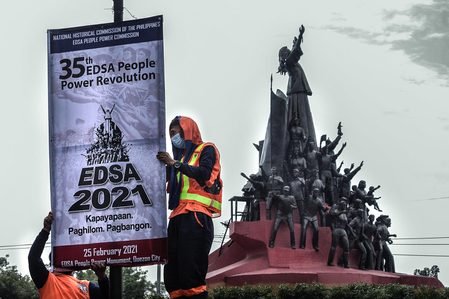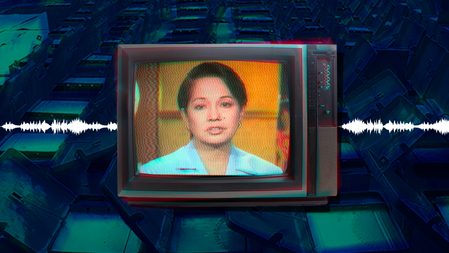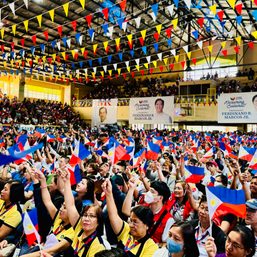SUMMARY
This is AI generated summarization, which may have errors. For context, always refer to the full article.
![[OPINION] Politics in review: Nothing ‘beats’ the Duterte administration](https://www.rappler.com/tachyon/2021/03/digong-admin-March-16-2021.jpg)
It is almost 2022, and we already see signs that next year is an election year, what with the not-so-subtle campaign streamers of wannabes all around. Even if the candidate denies that he or she has intentions of running, the promo materials we see online and on the streets say otherwise.
I thought it was illegal to display campaign materials until it was election time. Why is this even allowed? Such illustrates the politics and “rule of law” that thrive in our country.
Before Martial Law, the political landscape in the Philippines was pretty much like that in the United States. Naturally because we were colonized by the Americans after we were a Spanish colony. That is why we have our Western education along with our Judeo-Christian religion. There were two predominant parties, the Nacionalista and Liberal, distinct from each other along platform lines, not personalities. The President and Vice President belonged to the same party, which made a lot of sense – the dominance of wealthy political families notwithstanding.
Then came Martial Law after the two elected terms of Ferdinand Marcos, which extended until the EDSA Revolution in 1986. The Marcos era lasted nearly 21 years. All constitutional provisions were suspended, supplanted by the whims and caprices of just one man. Opposition to the one-man rule was eliminated. And who could execute that but the coercive power of the state commanded by that one man: the security services, namely the police and the military, especially the latter which had bigger guns.
Autocracy and corruption
Then the New Society that was established following the dismantling of the old oligarchies began to crumble. The New Society replaced the old elites with new cronies endeared to the “Apo” in Malacañang. Soon the cronies themselves and political warlords were vying for supremacy in the absence of checks and balances to moderate their greed.
Corruption becomes even more irresistible in autocratic regimes because the temptation to monopolize and control supply and demand is much greater. The lawmaking body and final arbiter of the law are basically stamp-pads of the all-powerful chief executive. Political decay led to public discontent. The uprising on the streets was therefore the result of years of abuse by a governor upon the governed.
Then came EDSA in 1986. If some still question whether or not it was a revolution, then they do not know what defines a revolution – which is the “forcible overthrow of a government or social order in favor of a new system.” The EDSA Revolution of 1986 was indeed one. The relatively peaceful but forcible overthrow of the decadent Marcos regime was so successful that it was copied worldwide by other countries dissatisfied with their abusive rulers.
EDSA was a shining moment in Philippine political history as it restored democracy. Rebellious elements of the military rallied behind the withdrawal of support, led by Juan Ponce Enrile and Fidel Ramos, both fair-haired boys of the dictator. The extent of public discontent with the decayed regime was seen and felt in the throng of people that crowded EDSA upon the call of Jaime Cardinal Sin, as well as the simultaneous protests in the regions. In fact, the shift of air power to the rebel side almost coincided with the actual departure of Marcos to Hawaii, not Paoay.
Corazon Aquino wasted no time in being proclaimed president, a title she actually won even before the attempted coup. Supreme Court Justice Claudio Teehankee presided over the transfer of power at the Club Filipino in Greenhills, San Juan. I was there as a military rebel to witness the historic event.
Anti-coup force
Democracy was restored in the Philippines but not the challenges to it. Seven coup attempts tried to overthrow the government of Corazon Aquino between 1986 and 1992. Two were exceptionally violent: August 1987 and December 1989.
My unit, the Philippine Constabulary Special Action Force (SAF), became an anti-coup force. The allies we had before and during EDSA became our enemies, as they tried to grab power in favor of frustrated political oligarchs. Gregorio Honasan’s men trained us only to see us become their enemies. But democracy survived the Aquino years.
The transition from Corazon Aquino was led by Fidel Ramos, a military man who was Marcos’ longest Philippine Constabulary chief, martial law implementor, and a cousin. Ramos exemplified change and encouraged others in the military to do the same, which was that he was magnanimous to returning Marcos loyalists.
Many of these men who hold power today owe their lot to Ramos. “Tabako,” as he is fondly called, was relatively successful in restoring competent political leadership in his country. He graduated from West Point and used his leadership and management skills well as commander-in-chief. He made peace with rebels from the Left to the Right. There were zero coup attempts in his term.
From ‘tiger’ to ‘midnight Cabinet’
Ramos aimed to make the Philippines the new “tiger” economy in Asia, a goal hampered by the 1997 Asian financial crisis. Unlike Marcos who used his wife Imelda for diplomatic state visits, it was Ramos himself who marketed the new Philippines to many countries in the world. I know because we covered his movements as members of his Presidential Security Group. Competitive governance and economic recovery were hallmarks of the Ramos legacy.
But this became short-lived as Joseph “Erap” Estrada quickly replaced it with shameless incompetence and laziness. The Cabinet meetings and Legislative Executive Development Advisory Council meetings were replaced by “midnight Cabinets” of all-night drinking and womanizing right inside Malacañang. Erap worked afternoons only and had no morning appointments as he would be asleep from the previous night’s drinking spree.
Corruption came to the surface as gambling lords lorded it over, claiming affinity to the power center. The Erap administration was so bad that Erap was overthrown by another withdrawal of support by the military led by Angelo Reyes halfway through its term. Incompetence and inability to complete one’s term of office were the legacy of the Estrada period.
Promising star
Gloria Macapagal Arroyo (GMA) was a promising rising star in Philippine politics who ended up in a collar and under house arrest.
The daughter of a former president, the Georgetown-educated doctor of philosophy was caught on tape talking with an elections commissioner about her votes relative to her rival’s, Fernando Poe Jr., during the 2004 elections. Most of the nine long years of the GMA administration were spent in corrupting the military so that she could stay in power. The “Hello, Garci” scandal led to a revolving door policy in the military where 11 Armed Forces (AFP) chiefs of staff ruled in her 9 years in office. The most number of AFP chiefs of staff and massive corruption are the GMA administration’s legacy.
Then-AFP chief of staff Hermogenes Esperon Jr., a GMA favorite, once said he would finish off the NPA in just a few years – to coincide with the end of her term in 2010. The AFP then, as the AFP now, targeted the supposed front organizations, using hawkish generals like Jovito Palparan. But until now, the local communist insurgency is still very much around, thanks to the root causes of insurgencies worldwide.
In 2010, another presidential child came into power after that other presidential child: Benigno Aquino III aka Noynoy.
This Aquino came into power with a big bang, but left it with a whimper. Many voted for him hoping that his clean image then would cleanse the bureaucracy of its corruption curse. They were massively disappointed as among the biggest corruption scandals were those perpetrated during the second Aquino period.
They include the MRT fund mess that resulted in the slowest moving commuter train in Asia today. There was the favoritism in the AFP, discarding the seniority lineal list meritocracy in favor of selecting shooting buddies, their incompetence notwithstanding. Noynoy did very well in improving the Philippines’ economic performance. But he erred in sanctioning a delicate mission through insurgent territory for personal glory, but left behind 44 special elite forces of the Philippine National Police (PNP) to die mercilessly at the hands of enemies in broad daylight. The Mamasapano massacre remains Aquino III’s enduring legacy, which is more of a nightmare. In fairness to Aquino, though, all the AFP and PNP generals who stood by without lifting a finger are as guilty as their frightful leader. They were all guilty of being spineless in doing nothing for beleaguered comrades. I even personally took offense at this cowardice and betrayal as I had been a SAF pioneer when it was still in the AFP.
We had been warned
But nothing beats this administration of Rodrigo Duterte, aka Digong, that we have today. In fairness to the man, he had warned that giving him the power would lead to untold carnage. We did not listen. And so it happened.
Many saw promise in Digong as they had with other candidates in years past. The massive and unstoppable corruption made the public scream for radical change. For radical leadership. For Rodrigo Duterte. Ramos’ disdain for “dilawans” under Noynoy Aquino made him endorse Digong, who eventually stopped listening to his advice thereafter. Then the extrajudicial killings happened a la Davao, with those killed numbering at least 20,000 by various accounts. Then the pivot to China and away from a longtime ally, the US. Then the intensified counterinsurgency strategy backed by a new anti-terrorism law.
China used to be in the AFP’s Order of Battle list of enemies. Its communist ideology is far from our predominantly Judeo-Christian faith. Its political structure and operational ways and means are certainly opposed to our more democratic rule of law. Its support of the local communists was what put it in our Order of Battle list in the first place.
I don’t even understand the logic behind again launching another aggressive campaign against the domestic communist insurgents when we are not lifting a finger against the much bigger foreign threat that is communist China.
A Visiting Forces Agreement with the US, as part of our Mutual Defense Treaty with them, also binds our former colonial master to support us in case of a shooting war. We must always be wary of China because China is the biggest country-multinational corporation in the world, and its below- war-theater level of engagement already means that it is currently at war with anything and everything opposed to its national security and interest.
Why this fascination with China? Current efforts to change the Constitution will also favor China. There may be some provisions in the 1987 Constitution I disagree with, but I do not think the problem here is the Constitution. The real problem is the people pushing for such change for self-serving motives.
The legacy of the Digong administration is unfinished. But the tell-tale signs are already ominous. The administration is still ongoing and may even be continuing, what with those campaign banners already around us! – Rappler.com
A public servant and patriot, retired Colonel Dencio Acop graduated from West Point in 1983. After serving in the Philippine Constabulary and Philippine Army, he worked in the corporate sector and now writes freelance.
Add a comment
How does this make you feel?



![[EDITORIAL] Ang low-intensity warfare ni Marcos kung saan attack dog na ang First Lady](https://www.rappler.com/tachyon/2024/04/animated-liza-marcos-sara-duterte-feud-carousel.jpg?resize=257%2C257&crop=294px%2C0px%2C720px%2C720px)
![[Free to disagree] How to be a cult leader or a demagogue president](https://www.rappler.com/tachyon/2024/04/TL-free-to-disagree.jpg?resize=257%2C257&crop_strategy=attention)
![[OPINION] Can Marcos survive a voters’ revolt in 2025?](https://www.rappler.com/tachyon/2024/04/tl-voters-revolt-04042024.jpg?resize=257%2C257&crop=251px%2C0px%2C720px%2C720px)
![[Edgewise] Quo vadis, Quiboloy?](https://www.rappler.com/tachyon/2024/03/quo-vadis-quiboloy-march-21-2024.jpg?resize=257%2C257&crop_strategy=attention)
There are no comments yet. Add your comment to start the conversation.